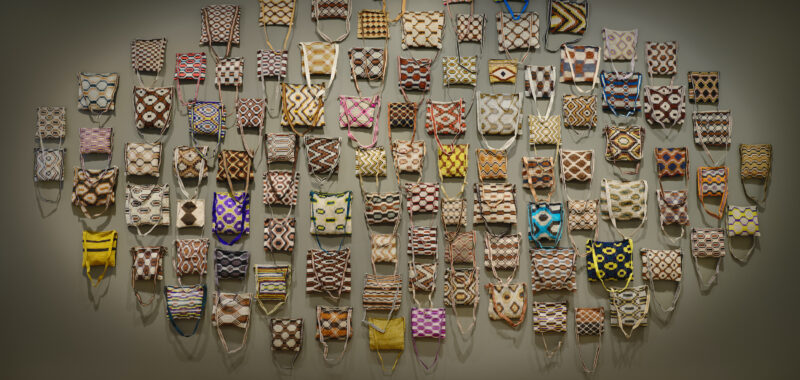The first time that I and many others encountered the wonderful, semi-abstract, vividly colored textile artworks by Claudia Alarcón and the art collective she helped form, Silät, was at the 60th International Art Exhibition at the 2024 Venice Biennale. A multigenerational collective of 100 Indigenous Wichí women weavers from northern Salta, Argentina, Silät came together in 2023 when a previous group disbanded. Its name, I’ve learned, means “message,” although elsewhere I have also read “notice” and “alert.”
Communal weaving by women using the fibers of the forest plant chaguar, colored by natural dyes, has long been fundamental in matrilocal Wichí society: In their mythology, women lived in the heavens as stars and descended to earth on chaguar ropes. This has commonly involved yicas, handwoven bags with intricate geometric patterns that are used for carrying food and convey memories and narratives. “Un coro de yicas” (A chorus of yicas) (2024–25), a towering wall installation of 100 yicas, each made by a member of the collective and with a unique design, encapsulates the impressive range and variety of these artworks.

Argentine curator Andrei Fernández, as well as María Carri and Alarcón, have been instrumental in propelling Wichí weaving into innovative new forms, especially via large-scale works and contemporary art contexts. The greatly enhanced visibility and economic potential that have resulted are very good things given the dire threats Wichís face from cattle-farming settlers, deforestation, poverty, racism, and governmental abuse.
Large, communally made textile works (up to around six by six-and-a-half feet), displayed on the walls like paintings, employ the traditional yica stitch that Wichí women have been using for centuries. They result in web-like structures that one both looks at and through. Like eyes, they are open to the world and the heavens, channeling land, celestial bodies, and human and nonhuman animals. Two pieces by Alarcón herself in the viewing room employ the more tightly woven antique stitch. I advise seeking them out; they are great.

With its irregular geometric shapes and zigzagging bands in multiple colors, “Los caminos de la presencia wichí” (The paths of the Wichí presence) (2024) feels like a voyage, or perhaps several ones, not a static artwork. It’s good to look from afar, up close, and from the sides at its fluctuating shapes and color gradations. This work feels very generous and soulful, as do the others.
“Nosotras, hijas de las estrellas” (We, daughters of the stars) (2025) connects the present to the mythological Wichí origin story. Yellow shapes that resemble stars glow near the top. Below them is what might be the merest hint of a human figure, while gray sections woven into a whole are like the night assembled in pieces. Russet and off-white zigzags are pure, coursing energy and seem to oscillate and pulsate. This is one of several celestial-themed pieces in the show.
Geometric abstraction in these works intersects with different styles of South American and Modernist abstraction. I’m struck, though, by Alarcón’s assessment: “The geometric shapes we make in the fabric have meanings; each one is a message. Some shapes reference birds, footprints, cat’s eyes, our landscape […].” A profound connection with the environment that the Wichís have inhabited for millennia is palpable in these ambitious, deeply moving textiles. The whole exhibition asserts the importance of Wichí aesthetics, cosmology, and society at this very precarious time.



Claudia Alarcón & Silät continues at James Cohan Gallery (52 Walker Street, Tribeca, Manhattan) through May 10. The exhibition was curated by Andrei Fernández.

